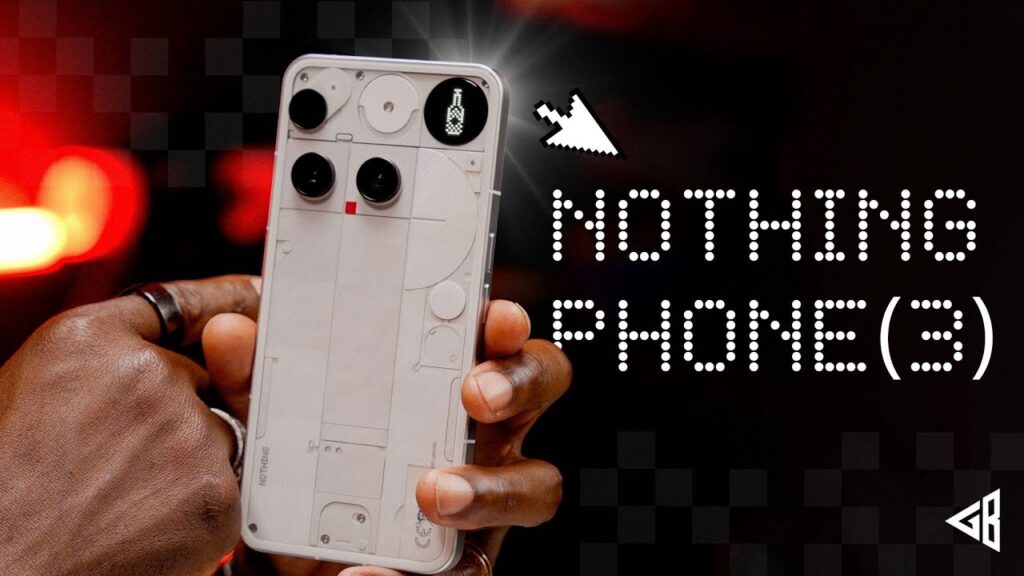The Nothing Phone 3, launched in July 2025, marks the company’s ambitious leap into the flagship smartphone arena. Priced at $799 for the base 12GB/256GB model and $899 for the 16GB/512GB variant, it’s a significant jump from its mid-range predecessors. With a unique design, a revamped Glyph Matrix, and solid hardware, Nothing aims to challenge heavyweights like the Samsung Galaxy S25 and Google Pixel 9. But does it deliver a true flagship experience, or is it caught in a quirky middle ground? Let’s dive into the details.

Design: Unmistakably Nothing
Nothing’s design philosophy has always been about standing out, and the Phone 3 doesn’t disappoint. The transparent glass back, a signature since the Phone 1, returns with a more refined three-column grid layout, showcasing screws and hardware modules in a visually striking, almost industrial aesthetic. At 160.6 x 75.6 x 9.0mm and 218g, it’s heavier and thicker than some rivals, but the aluminum frame and Gorilla Glass Victus (back) and 7i (front) lend a premium feel. The IP68 rating for dust and water resistance is a welcome addition, ensuring durability.
The standout feature is the new Glyph Matrix, a dot-matrix display replacing the iconic Glyph LED strips. Comprising 489 LEDs, it’s more versatile, offering widgets like a clock, selfie mirror, or even playful mini-games like Rock Paper Scissors. While fun, its practicality is debatable—many users may find it a novelty rather than a daily driver feature. The Essential Key, a dedicated button for quick access to AI-powered Essential Space, is a nice touch but feels underutilized due to limited app integration. The asymmetrical camera layout, with three 50MP lenses in square housings, sparks curiosity but may irk those who prefer symmetry.
Display: Bright and Vibrant
The Nothing Phone 3 sports a 6.67-inch OLED display with a 1260×2800 resolution and 460ppi. Its 120Hz refresh rate ensures smooth scrolling, and the 1,000Hz touch sampling rate is a boon for gamers. With a peak brightness of 4,500 nits (1,600 nits outdoors), it’s among the brightest screens in its class, handling direct sunlight with ease. The 2160Hz PWM dimming reduces eye strain, and HDR10+ support delivers rich colors for streaming. However, the lack of LTPO technology, found in competitors like the Galaxy S25, means less dynamic refresh rate adjustment, slightly impacting battery efficiency.
Performance: Solid, But Not Elite
Powered by the Qualcomm Snapdragon 8s Gen 4, paired with up to 16GB LPDDR5X RAM and 256GB/512GB UFS 4.0 storage, the Phone 3 is no slouch. It handles multitasking, gaming (like Zenless Zone Zero at high settings), and daily tasks smoothly, with Geekbench 6 scores around 2,106 (single-core) and 6,596 (multi-core). However, the 8s Gen 4, a sub-flagship chip, lags behind the Snapdragon 8 Elite in devices like the Galaxy S25 or OnePlus 13, which offer 10-25% better performance. For most users, this gap is negligible, but at $799, the expectation for top-tier silicon is reasonable.
Camera: Versatile but Inconsistent
The Phone 3 boasts a triple 50MP rear camera setup: a main sensor with OIS, a 3x periscope telephoto with OIS, and an ultra-wide with a 114-degree field of view. A 50MP selfie camera completes the package. In good lighting, the main camera shines with accurate colors and strong detail, while the telephoto lens offers decent 3x optical and 6x digital zoom. The ultra-wide performs well but struggles with edge distortion. Low-light performance is a weak point, with occasional loss of detail and inconsistent color balance across lenses. Compared to the Pixel 9 or iPhone 16, the Phone 3’s cameras are good but fall short of flagship consistency.
Software: Nothing OS Shines
Running Nothing OS 3.5 on Android 15, the Phone 3 offers a clean, bloat-free experience with a monochrome, dot-matrix aesthetic. Custom widgets, a drag-and-drop quick settings grid, and Essential Search—a universal search bar for apps, contacts, and web queries—add a playful yet practical touch. Essential Space, an AI-driven feature for organizing screenshots and recordings, is innovative but lacks third-party app integration. Nothing promises five years of OS updates and seven years of security patches, trailing Samsung and Google’s seven-year commitments but still respectable.
Battery and Charging: Reliable but Not Record-Breaking
The 5,150mAh silicon-carbon battery delivers solid endurance, lasting around 24 hours with heavy use (8 hours of screen-on time). In testing, it achieved 8.5 hours in PCMark’s battery test, lagging behind competitors like the Vivo X200 FE (6,500mAh). The 65W wired charging fills the battery in about 50 minutes, faster than many rivals, while 15W wireless and 5W reverse wireless charging are welcome additions. However, the absence of Qi2 support is a minor miss.
Verdict: A Charmer with Compromises
The Nothing Phone 3 is a bold, quirky contender that nails the essentials—design, display, and software—while falling short in flagship-level performance and camera consistency. Its $799 price pits it against the Galaxy S25, Pixel 9, and iPhone 16, which offer superior chipsets and cameras. Yet, its unique aesthetic, clean Nothing OS, and innovative features like the Glyph Matrix make it a compelling choice for those prioritizing style and personality over raw specs. If you’re a Nothing fan or crave a phone that stands out, the Phone 3 is a worthy pick. For spec-chasers, better value lies elsewhere.
Pros
- Striking, transparent design with a premium build
- Bright, vibrant 6.67-inch OLED display
- Clean, customizable Nothing OS 3.5
- Solid battery life and fast 65W charging
- Versatile triple 50MP camera system
Cons
- Snapdragon 8s Gen 4 lags behind flagship chips
- Camera performance inconsistent in low light
- Glyph Matrix feels more gimmicky than essential
- Priced high for its specs compared to rivals
